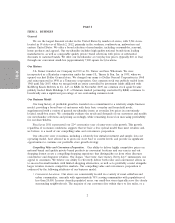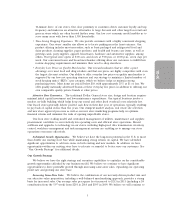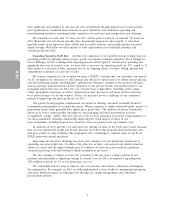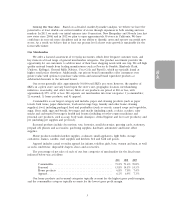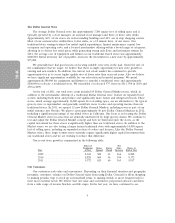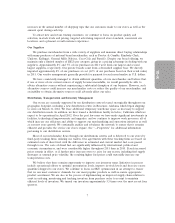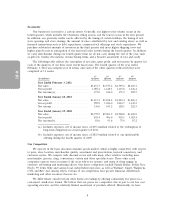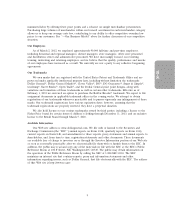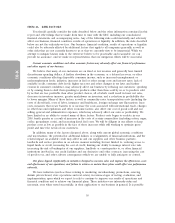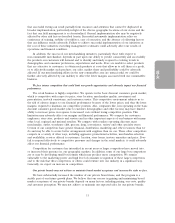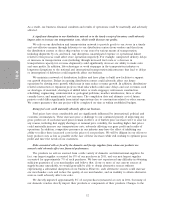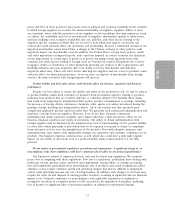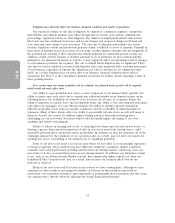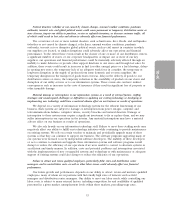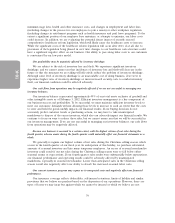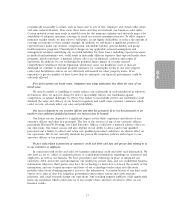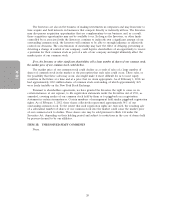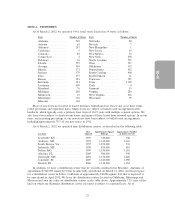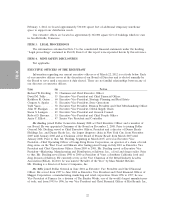Dollar General 2011 Annual Report Download - page 112
Download and view the complete annual report
Please find page 112 of the 2011 Dollar General annual report below. You can navigate through the pages in the report by either clicking on the pages listed below, or by using the keyword search tool below to find specific information within the annual report.
10-K
As a result, our business, financial condition and results of operations could be materially and adversely
affected.
A significant disruption to our distribution network or to the timely receipt of inventory could adversely
impact sales or increase our transportation costs, which would decrease our profits.
We rely on our distribution and transportation network to provide goods to our stores in a timely
and cost-effective manner through deliveries to our distribution centers from vendors and then from
the distribution centers or direct ship vendors to our stores by various means of transportation,
including shipments by sea and truck. Any disruption, unanticipated expense or operational failure
related to this process could affect store operations negatively. For example, unexpected delivery delays
or increases in transportation costs (including through increased fuel costs or a decrease in
transportation capacity for overseas shipments) could significantly decrease our ability to make sales
and earn profits. In addition, labor shortages or work stoppages in the transportation industry or
long-term disruptions to the national and international transportation infrastructure that lead to delays
or interruptions of deliveries could negatively affect our business.
We maintain a network of distribution facilities and have plans to build new facilities to support
our growth objectives. Delays in opening distribution centers could adversely affect our future
operations by slowing store growth, which may in turn reduce revenue growth. In addition, distribution-
related construction or expansion projects entail risks which could cause delays and cost overruns, such
as: shortages of materials; shortages of skilled labor or work stoppages; unforeseen construction,
scheduling, engineering, environmental or geological problems; weather interference; fires or other
casualty losses; and unanticipated cost increases. The completion date and ultimate cost of future
projects could differ significantly from initial expectations due to construction-related or other reasons.
We cannot guarantee that any project will be completed on time or within established budgets.
Rising fuel costs could materially adversely affect our business.
Fuel prices have risen considerably and are significantly influenced by international, political and
economic circumstances. These increases pose a challenge to our continued priority of improving our
gross profit rate. If such increased prices remain in effect, or if further price increases were to arise for
any reason, including fuel supply shortages or unusual price volatility, the resulting higher fuel prices
could materially increase our transportation costs, adversely affecting our gross profit and results of
operations. In addition, competitive pressures in our industry may have the effect of inhibiting our
ability to reflect these increased costs in the prices of our products. We will be diligent in our efforts to
keep product costs as low as possible in the face of these increases while still working to optimize gross
profit and meet the needs of our customers.
Risks associated with or faced by the domestic and foreign suppliers from whom our products are
sourced could adversely affect our financial performance.
The products we sell are sourced from a wide variety of domestic and international suppliers. In
fact, our largest supplier accounted for 8% of our purchases in 2011, and our next largest supplier
accounted for approximately 7% of such purchases. We have not experienced any difficulty in obtaining
sufficient quantities of core merchandise and believe that, if one or more of our current sources of
supply became unavailable, we would generally be able to obtain alternative sources without
experiencing a substantial disruption of our business. However, such alternative sources could increase
our merchandise costs and reduce the quality of our merchandise, and an inability to obtain alternative
sources could adversely affect our sales.
We directly imported approximately 8% of our purchases (measured at cost) in 2011, but many of
our domestic vendors directly import their products or components of their products. Changes to the
12


